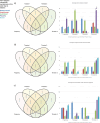Prenatal ambient air pollution associations with DNA methylation in asthma- and allergy-relevant genes: findings from ECHO
- PMID: 40438471
- PMCID: PMC12118459
- DOI: 10.1093/eep/dvaf013
Prenatal ambient air pollution associations with DNA methylation in asthma- and allergy-relevant genes: findings from ECHO
Abstract
Prenatal exposure to air pollution is an important risk factor for child health outcomes, including asthma. Identification of DNA methylation changes associated with air pollutant exposure can provide new intervention targets to improve children's health. The aim of this study is to test the association between prenatal air pollutant exposure and DNA methylation in developmental and asthma-/allergy-relevant biospecimens (placenta, buccal, cord blood, nasal mucosa, and lavage). A subset of 2294 biospecimens collected from 1906 child participants enrolled in the Environmental Influences on Child Health Outcomes program with prenatal air pollutant and high-quality Illumina Asthma&Allergy DNA methylation array measures (n = 37 197 probes) were included. Prenatal ozone, nitrogen dioxide, and fine particulate matter were derived using residential history during pregnancy and spatiotemporal models. For each pollutant, biospecimen type, and prenatal exposure window, we estimated the effects of air pollution on gene DNA methylation levels. We compared results across pollutants, biospecimen types, and trimesters and tested for critical months of exposure using distributed lag models. DNA methylation levels at 154 out of 4746 tested genes were associated with air pollution; over 95% were exposure window, pollutant, and biospecimen-type specific. The fewest gene associations were detected in trimester 2, relative to other exposure windows. A variety of trends in methylation patterns were observed in response to lagged monthly pollution levels. Child DNA methylation changes at specific respiratory- and immune-relevant genes are associated with prenatal air pollutant exposures. Future studies should examine the relationship between these pollution-sensitive genes and child health.
Keywords: DNA methylation; Environmental influences on Child Health Outcomes (ECHO); prenatal air pollution.
© The Author(s) 2025. Published by Oxford University Press.
Conflict of interest statement
Dr C.L.-A. reports consulting fees from the University of Iowa for providing expertise on autism epigenetics, outside the scope of this work. All other authors have no conflicts to declare.
Figures


References
-
- Abbasi-Kangevari M, Malekpour MR, Masinaei M et al. ; GBD 2019 North Africa and the Middle East Air Pollution Collaborators . Effect of air pollution on disease burden, mortality, and life expectancy in North Africa and the Middle East: a systematic analysis for the Global Burden of Disease Study 2019. Lancet Planet Health 2023;7:e358–69. doi: 10.1016/S2542-5196(23)00053-0 - DOI - PMC - PubMed
Grants and funding
LinkOut - more resources
Full Text Sources

